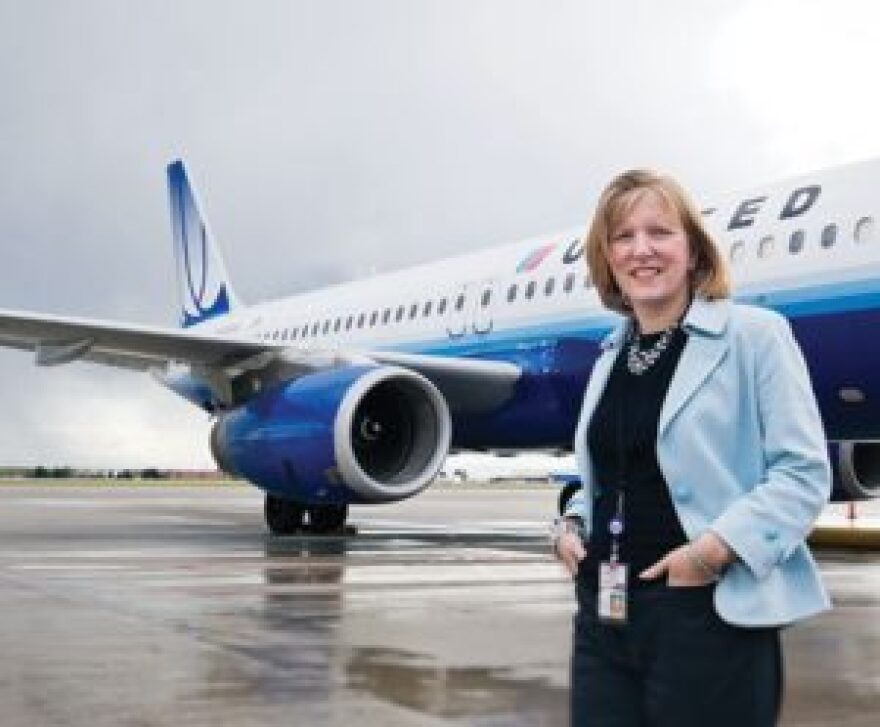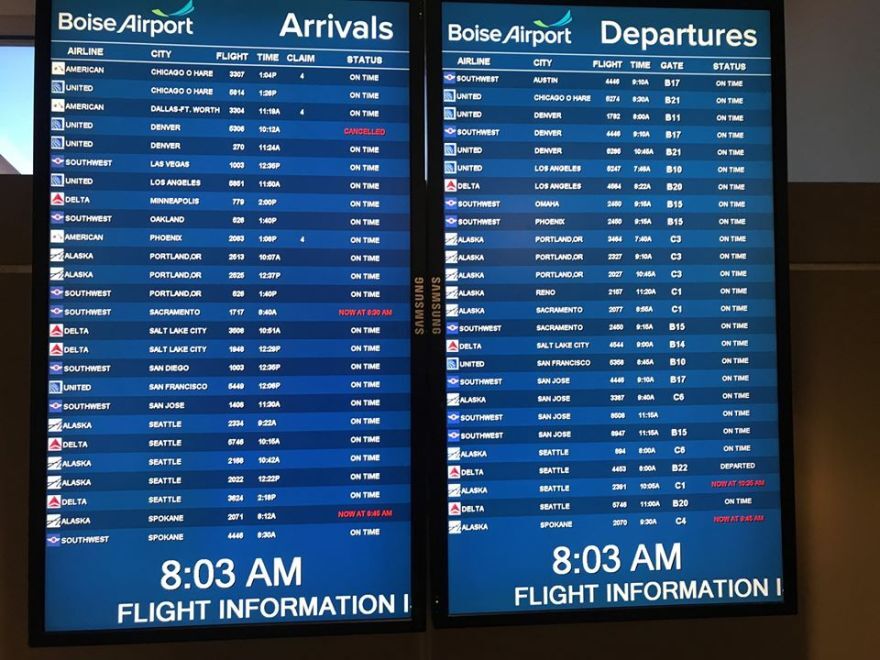While some of the world’s biggest airports inch their way back to pre-pandemic service, the Boise airport has rebounded in a big way.
“Based on anecdotal information, such as the number of passengers through the TSA checkpoint, parking and also concession sales, all signs indicate that we are back to, or exceeding, the passenger travel levels that we saw in 2019, which was a record year for Boise,” said Boise Director Rebecca Hupp.
Just this week, it was announced that Boise’s airport is expected to be reclassified from a small- to a medium-size hub. With that classification also comes a few new requirements; but the airport’s team was already well underway with the upgrades.
Hupp visited with Morning Edition host George Prentice to talk about the resurgence of passenger travel, the recent addition of more one-way destinations and a few reminders for travelers who may not have flown in a while.
“We have added significant capacity in our market. In fact, in July we are expecting the number of seats available in our market to be 20 percent higher than what it was in July of 2019.”Rebecca Hupp
Read the full transcript below:
GEORGE PRENTICE: It is Morning Edition on Boise State Public Radio News. Good morning. I'm George Prentice. Well, more of us are making plans… immediate plans…, and future plans for travel. And you need look no further than the Boise airport to see just that. Rebecca Hupp is here. She's director of the Boise Airport, which is, again, one of the busiest places in the region. Rebecca, good morning.
REBECCA HUPP: Good morning, George. Thank you for the invitation.
PRENTICE: So let's talk about that: Everything that I've seen and certainly heard is that it appears that, at least leisure travel is rebounding, in a big way.

HUPP: You are correct. We are seeing a strong recovery in the Boise market. And I think throughout the pandemic, what we've seen is that our travel never really reached the bottom that some other places did. And then we continue to recover at a quicker rate, generally about 10 percent faster than the rest of the country. And I would say by April, we were back to about 80 percent of pre-pandemic travel. And we do not have numbers yet for May; but based on anecdotal information, such as the number of passengers through the TSA checkpoint, parking and also concession sales, all signs indicate that we are back to, or exceeding, the passenger travel levels that we saw in 2019, which was a record year for Boise.
PRENTICE: You're coming up on your 10th anniversary. Do I have that right?
HUPP: You're very close. I just passed nine years in April, so I'm well on my way to 10 years.
PRENTICE: Well, during the many times we've spoken over the years, you've told me that to get direct routes from Boise to cities like New York or Atlanta or Dallas, it wouldn't take one thing… it wouldn't take two things…it would take a constellation of things. And now here you are with…. well, how many direct flight destinations are you at right now?
HUPP: We are at 28 destinations nonstop from Boise.
PRENTICE: So that does now include New York and Atlanta and Dallas and Chicago.
HUPP: It actually includes Dallas Love Field, which is the second Dallas location, also Chicago O'Hare and Chicago Midway. But just since the pandemic, we have added Atlanta, Palm Springs, Nashville, Orange County, Austin, Pullman and Moscow, Everett, and New York City,
PRENTICE: Plus extra services on existing routes.
HUPP: Yes, additional competition on the route to Phoenix, on the route to Chicago, and San Jose.
PRENTICE: So, is this a reflection of a growth of our region?

HUPP: It's a constellation of things. It is the growth of the region. Boise, as everyone knows, is one of the fastest growing, if not the fastest growing area in the country. So that certainly is a contributor. But the other thing that's contributing to it is the airlines are looking for places to add service where they can be successful. We are still not seeing business travel return in many markets and we're not seeing international travel returning in many markets. Airlines have aircraft that they're looking for new and different ways. And that is, at least in part, what's leading to some of these additional destinations.
PRENTICE: Let's talk about a bit of news: This week, it was announced that the Boise Airport is preparing to be reclassified as a medium hub this fall. I understand the significance of that administratively, but what might that mean to me as a customer?
HUPP: So, I think for a customer, it probably will be relatively seamless; but what it means is that Boise is one of the largest airports in the country, and we like to think of Boise is our airport - a small airport that's convenient and easy to get through and to. And we absolutely want to maintain that. But we are becoming a larger player in the national transportation system. And so, for the customer, I think it will probably be relatively seamless, although we are seeing more passengers travel. So that means more congestion in the parking area, it means more congestion at the security checkpoint, it means all of the aircraft parking gates are full. All of those things from an administrative perspective… there are some changes for us in terms of the way FAA calculates our grant funding and some of the regulatory requirements that exist. So, we'll have to go through some extra hoops. But I think for the passenger, it will be relatively seamless. But again, it's just an indication of the fact that Boise is growing and the number of non-stop destinations that we are offering continues to contribute to this
PRENTICE: At any given time. I know you've got probably a dozen, if not more, construction projects going on, but what caught my interest recently is a service animal relief area and a nursing room at the airport. Tell me about those.
HUPP: Those actually are both items that are required if you are a medium hub, but not if you are a small hub. Boise has long been on the cusp of that small to medium hub delineation. And so that was something that has been in the planning process for over a year. And we've started construction. But we also think it's important that the airport be accessible to everyone. And the service animal relief area allows people who are traveling with service animals to have a relief area for their animals past security screening. We do have a service animal relief area, pre-security screening. But until this point, we haven't had one past security screening. And then we had a temporary nursing pod, which was not required and didn't meet all of the specifications for a nursing room. This will be a more permanent nursing room that will have a sink in it and an electrical outlet.
PRENTICE: Speaking of security, I'm guessing that it's as busy as ever. I'd be remiss if I didn't ask to remind us that we need to get to the airport on time.
HUPP: I think people want to get to Boise maybe not as early as they would at some other airports. But it's important to remember that we can only get so many people through the security checkpoint at a time. And so, people need to arrive 90 minutes to two hours early. Airlines will always board aircraft 30 minutes prior to departure. So, if you only get there an hour early, you are not allowing yourself sufficient time to get through the security screening process and get to your gate.
PRENTICE: When is your next vacation?
HUPP: Funny you should ask. I am taking the day and I am doing a weekend trip to Nashville.
PRENTICE: Very nice. To get Rebecca Hup to stand still for a couple of minutes and chat with us is a pretty big deal. So, safe travel to you, and thanks for giving us some time this morning.
HUPP: Thank you. I've really enjoyed talking with you this morning, George.
Find reporter George Prentice on Twitter @georgepren
Copyright 2021 Boise State Public Radio



